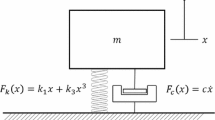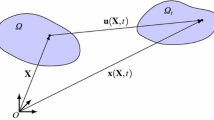Abstract
Most engineering applications involving vibrating structures are nonlinear in nature and many techniques have been recently investigated to provide a better understanding of such problems. Among the large variety of methods, the harmonic probing has presented useful properties for identification and dynamic analysis of nonlinear systems. The method is conventionally described by the multi-dimensional Fourier transform of the Volterra kernels and it depends on the knowledge of the equations of motion and the respective input and output data. However, this white-box methodology is limited to applications where the input signal is either unknown or even unmeasured. Thus, the present paper is concerned with the development of an extended version of the harmonic probing method to deal with applications where only the outputs are available. The algebraic expressions of the extended Volterra kernels transform and their theoretical properties are provided. The main advantages, novelties and drawbacks of this new approach are discussed and compared with the conventional approach. It is verified that the new kernels can be expressed as a combination of the conventional ones. Numerical tests based on a classical 2DOF Duffing oscillator are carried out and the results reveal the effectiveness and potential of the extended harmonic probing method based on a nonparametric model using new kernels to describe a prediction of vibrating systems in nonlinear regime of motion.








Similar content being viewed by others
References
Abed-Merain K (1997) Blind system identification. Proc IEEE 85(8):1310–1322. doi:10.1109/5.622507
Billings S (2013) Nonlinear system identification: NARMAX methods in the time, frequency, and spatio-temporal domain. Wiley, Chichester, UK
Billings S, Tsang K (1989) Spectral analysis for non-linear systems, part I: parametric non-linear spectral analysis. Mech Syst Signal Process 3(4):319–339. doi:10.1016/0888-3270(89)90041-1
Billings S, Tsang K (1989) Spectral analysis for non-linear systems, part II: interpretation of non-linear frequency response functions. Mech Syst Signal Process 3(4):341–359. doi:10.1016/0888-3270(89)90042-3
Cafferty S, Tomlinson G (1997) Characterization of automotive dampers using higher order frequency response function. J Automob Eng 211(3):181–203. http://pid.sagepub.com/content/211/3/181.refs
Carassale L, Kareem A (2010) Modeling nonlinear systems by Volterra series. J Eng Mech 136(6):801818. doi:10.1061/(ASCE)EM.1943-7889.0000113
Chatterjee A (2010) Structural damage assessment in a cantilever beam with a breathing crack using higher order frequency response functions. J Sound Vib 329(16):3325–3334. doi:10.1016/j.jsv.2010.02.026
Chatterjee A, Vyas N (2000) Convergence analysis of Volterra series response of nonlinear systems subjected to harmonic excitation. J Sound Vib 236(2):339–358. doi:10.1006/jsvi.2000.2967
Chatterjee A, Vyas NS (2003) Nonlinear parameter estimation in rotor-bearing system using Volterra series and method of harmonic probing. J Vib Acoust 125(3):299–306. doi:10.1115/1.1547486
Chatterjee A, Vyas NS (2004) Non-linear parameter estimation in multi-degree-of-freedom systems using multi-input Volterra series. Mech Syst Signal Process 18(3):457–489. doi:10.1016/S0888-3270(03)00016-5
Cheng C, Peng Z, Zhang W, Meng G (2017) Volterra-series-based nonlinear system modeling and its engineering applications: a state-of-the-art review. Mech Syst Signal Process 87:340–364. doi:10.1016/j.ymssp.2016.10.029
Cherif I, Abid S, Fnaiech F (2012) Nonlinear blind identification with three-dimensional tensor analysis. Math Probl Eng 2012:22, Article ID 284,815. doi:10.1155/2012/284815
Chesné S, Deraemaeker A (2013) Damage localization using transmissibility functions: a critical review. Mech Syst Signal Process 38(2):569–584. doi:10.1016/j.ymssp.2013.01.020
Grosel J, Sawicki W, Pakos W (2014) Application of classical and operational modal analysis for examination of engineering structures. Proc Eng 91:136–141. doi:10.1016/j.proeng.2014.12.035. http://www.sciencedirect.com/science/article/pii/S1877705814030537
Kalouptsidis N, Koukoulas P (2003) Blind identification of Volterra-Hammerstein systems. In: Statistical signal processing, 2003 IEEE Workshop, pp 202–205. doi:10.1109/SSP.2003.1289379
Kerschen G, Worden K, Vakakis AF, Golinval J (2006) Past, present and future of nonlinear system identification in structural dynamics. Mech Syst Signal Process 20(3):505–592. doi:10.1016/j.ymssp.2005.04.008
Lang Z, Park G, Farrar C, Todd M, Mao Z, Zhao L, Worden K (2011) Transmissibility of non-linear output frequency response functions with application in detection and location of damage in MDOF structural systems. Int J Non Linear Mech 46(6):841–853. doi:10.1016/j.ijnonlinmec.2011.03.009. http://www.sciencedirect.com/science/article/pii/S0020746211000333
Lee G (1997) Estimation of non-linear system parameters using higher-order frequency response functions. Mech Syst Signal Process 11(2):219–228. doi:10.1006/mssp.1996.0080
Li D, Ren WX, Hu YD, Yang D (2016) Operational modal analysis of structures by stochastic subspace identification with a delay index. Struct Eng Mech 59(1):187–207. doi:10.12989/sem.2016.59.1.187
Maia NMM, Silva JMM, Ribeiro AMR (2001) The transmissibility concept in multi-degree-of-freedom systems. Mech Syst Signal Process 15(1):129–137. doi:10.1006/mssp.2000.1356
Peng Z, Lang Z (2007) On the convergence of the Volterra-series representation of the Duffing’s oscillators subjected to harmonic excitations. J Sound Vib 305(12):322–332. doi:10.1016/j.jsv.2007.03.062
Rugh WJ (1981) Nonlinear system theory–the Volterra/Wiener approach. University Press, The Johns Hopkings, Baltimore
Schetzen M (1980) The Volterra and Wiener theories of nonlinear systems. Wiley, New York
Scussel O, da Silva S (2016) Output-only identification of nonlinear systems via Volterra series. ASME J Vib Acoust 138(4):041,012 (13 pages). doi:10.1115/1.4033458
Shiki SB, Lopes V Jr, da Silva S (2014) Identification of nonlinear structures using discrete-time Volterra series. J Braz Soc Mech Sci Eng 36(3):523–532. doi:10.1007/s40430-013-0088-9
da Silva S (2011) Non-linear model updating of a three-dimensional portal frame based on Wiener series. Int J Non Linear Mech 46(1):312–320. doi:10.1016/j.ijnonlinmec.2010.09.014
Storer D, Tomlinson G (1993) Recent developments in the measurement and interpretation of higher order transfer functions from non-linear structures. Mech Syst Signal Process 7(2):173–189. doi:10.1006/mssp.1993.1006
Tan HZ, Huang Y, Fu J (2008) Blind identification of sparse Volterra systems. Int J Adapt Control Signal Process 22(7):652–662. doi:10.1002/acs.1011
Tawfiq I, Vinh T (2003) Contribution to the extension of modal analysis to non-linear structure using Volterra funcitonal series. Mech Syst Signal Process 17(2):379–407. doi:10.1006/mssp.2002.1499
Thouverez F (1998) A new convergence criteria of Volterra series for harmonic inputs. In: IMAC XVI—16th international modal analysis conference, 2–5 February, Santa Barbara, vol 758, pp 723 – 727
Tomlinson G, Manson G, Lee G (1996) A simple criterion for establishing an upper limit to the harmonic excitation level of the Duffing oscillator using the Volterra series. J Sound Vib 190(5):751–762. doi:10.1006/jsvi.1996.0091. http://www.sciencedirect.com/science/article/pii/S0022460X96900917
Weijtjens W, Sitter GD, Devriendt C, Guillaume P (2014) Operational modal parameter estimation of MIMO systems using transmissibility functions. Automatica 50(2):559–564. doi:10.1016/j.automatica.2013.11.021
Worden K, Tomlinson GR (2001) Nonlinearity in structural dynamics. Institute of Physics, London
Worden K, Manson G, Tomlinson G (1997) A harmonic probing algorithm for the multi-input Volterra series. J Sound Vib 201(1):67–84. doi:10.1006/jsvi.1996.0746
Xia X, Zhou J, Xiao J, Xiao H (2016) A novel identification method of Volterra series in rotor-bearing system for fault diagnosis. Mech Syst Signal Process 66–67:557–567. doi:10.1016/j.ymssp.2015.05.006
Yang Y, Nagarajaiah S (2013) Output-only modal identification with limited sensors using sparse component analysis. J Sound Vib 332(19):4741–4765. doi:10.1016/j.jsv.2013.04.004
Zhao XY, Lang ZQ, Park G, Farrar CR, Todd MD, Mao Z, Worden K (2015) A new transmissibility analysis method for detection and location of damage via nonlinear features in mdof structural systems. IEEE/ASME Trans Mechatron 20(4):1933–1947. doi:10.1109/TMECH.2014.2359419
Acknowledgements
The authors would like to acknowledge the financial support provided by the São Paulo Research Foundation (FAPESP) by Grant Number 12/09135-3 and National Council for Scientific and Technological Development (CNPq) under Grants Numbers 47058/2012-0 and 203610/2014-8. The first author acknowledges his scholarship from the Coordination for the Improvement of Higher Education Personnel (CAPES). Additionally, the authors would like to thank the anonymous reviewers and professor Michael J. Brennan for their helpful review, relevant comments and useful suggestions.
Author information
Authors and Affiliations
Corresponding author
Additional information
Technical Editor: Kátia Lucchesi Cavalca Dedini.
Rights and permissions
About this article
Cite this article
Scussel, O., da Silva, S. The harmonic probing method for output-only nonlinear mechanical systems. J Braz. Soc. Mech. Sci. Eng. 39, 3329–3341 (2017). https://doi.org/10.1007/s40430-017-0723-y
Received:
Accepted:
Published:
Issue Date:
DOI: https://doi.org/10.1007/s40430-017-0723-y




